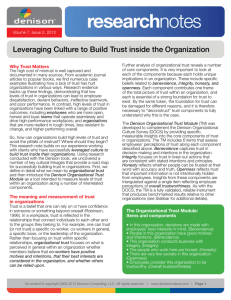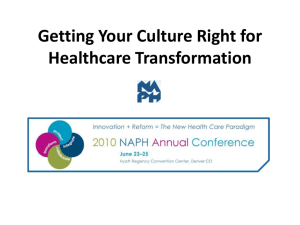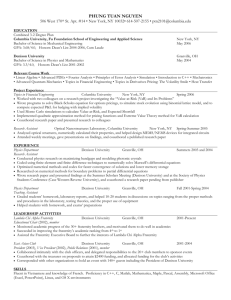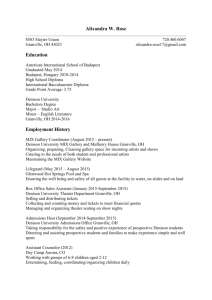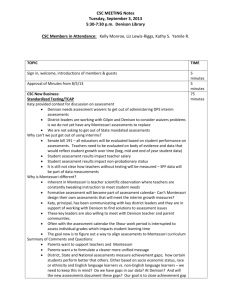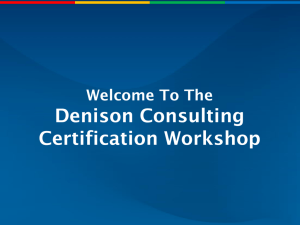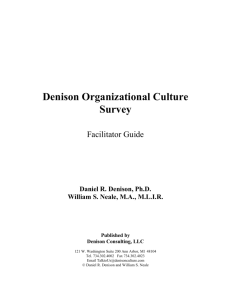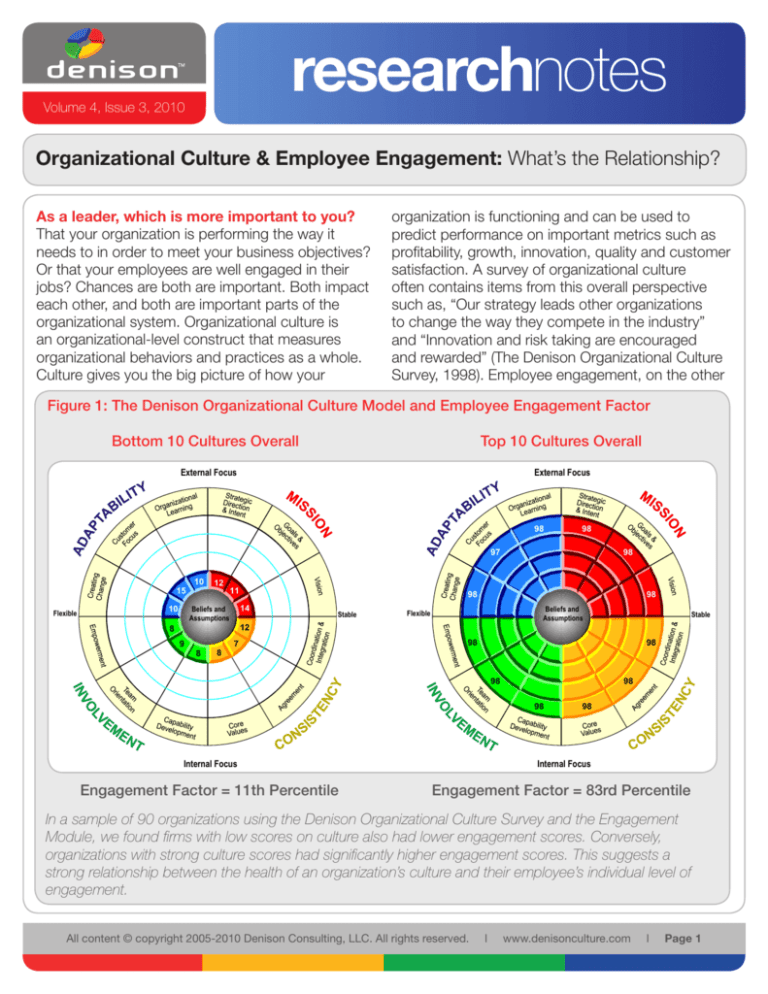
researchnotes
Volume 4, Issue 3, 2010
Organizational Culture & Employee Engagement: What’s the Relationship?
As a leader, which is more important to you?
That your organization is performing the way it
needs to in order to meet your business objectives?
Or that your employees are well engaged in their
jobs? Chances are both are important. Both impact
each other, and both are important parts of the
organizational system. Organizational culture is
an organizational-level construct that measures
organizational behaviors and practices as a whole.
Culture gives you the big picture of how your
organization is functioning and can be used to
predict performance on important metrics such as
profitability, growth, innovation, quality and customer
satisfaction. A survey of organizational culture
often contains items from this overall perspective
such as, “Our strategy leads other organizations
to change the way they compete in the industry”
and “Innovation and risk taking are encouraged
and rewarded” (The Denison Organizational Culture
Survey, 1998). Employee engagement, on the other
Top 10 Bottom 10 Engagment
Figure 1: The Denison Organizational Culture Model and Employee Engagement Factor
Bottom 10 DOCS Overall
Top 10 DOCS Overall
Bottom 10 Cultures Overall
Top 10 Cultures Overall
External Focus
External Focus
98
98
97
15
Flexible
10
10
12
11
8
9
8
8
98
14
Beliefs and
Assumptions
98
Stable
98
Beliefs and
Assumptions
Flexible
12
7
Stable
98
98
98
98
98
98
Internal Focus
Internal Focus
Engagement Factor = 11th Percentile
Engagement Factor = 83rd Percentile
In a sample of 90 organizations using the Denison Organizational Culture Survey and the Engagement
Module, we found firms with low scores on culture also had lower engagement scores. Conversely,
organizations with strong culture scores had significantly higher engagement scores. This suggests a
strong relationship between the health of an organization’s culture and their employee’s individual level of
engagement.
All content © copyright 2005-2010 Denison Consulting, LLC. All rights reserved.
l
www.denisonculture.com
l
Page 1
hand, measures your individual employees’ level of
engagement with their jobs and their organization.
Most employee engagement surveys are designed
to look at an individual’s behaviors and satisfaction
with their particular job. These types of surveys
best predict individual-level performance and often
include items such as: “I am passionate about my
work;” and “My manager gives me the tools and
resources I need to do my job.” As a leader or
manager, it’s important to know the extent to which
your employees are engaged. However, if employee
engagement is all you look at, you only see part of
the picture.
Understanding employee engagement is most
valuable when understood within the context of the
strengths and weaknesses of the organization. If
we look at employee engagement alone, without
considering the culture that employees work in,
we potentially leave ourselves blind to the strategic
strengths and weaknesses in the organization
that impact employee performance and ultimately
organizational performance. For instance,
consider an organization that measures employee
engagement and finds that both the Research &
Development department and the Sales Department
are highly engaged in their work. They may feel
confident that all is well within those departments
and that value is being created for their customers.
What the survey may not be telling them, however,
is that while both departments are working well
individually, neither department is communicating
with the other. This, in turn, is creating serious
challenges for their new product development
process and impacting future business opportunities
and growth. In fact, it is easy for an organization
to have very high engagement scores but also be
facing serious issues such as silos, misalignment or
distrust in the larger organization. Typical employee
engagement measures often say little about how the
organization works as a whole - making it difficult to
define a path forward without knowing the broader
context of the organization.
Our Approach to Employee Engagement
We provide leaders and managers the tools
necessary to ensure that the characteristics of
their organization (their culture) serve to inspire
employees to reach that heightened positive
state toward their job and organization we know
as engagement. At the core of our approach
is the Denison Organizational Culture Survey
(DOCS) which measures the overall health of an
organization. With proven links to organizational
performance such as profitability, growth,
innovation, customer satisfaction, employee
satisfaction and quality, the DOCS provides an
objective, reliable measure of the organization’s
strategic strengths and weaknesses. The Denison
Employee Engagement Module is an additional
brief and reliable measure of employee engagement
that helps leaders and managers understand how
their individual employees feel about their work and
the impact that the culture has on their attitudes
toward their job. By pairing these two surveys,
organizations can align their efforts and gain greater
clarity about their employees’ individual performance
and the organization’s performance.
Engagement is an Outcome of a Healthy
Culture
We believe employee engagement is an outcome of
a healthy culture, but as a research-based company,
we needed to do the work to prove it: What
aspects of culture most strongly relate to employee
engagement? To answer this question, we looked
at a sample of 9,464 individuals in 90 organizations
who completed both the Denison Organizational
Culture Survey and the Denison Engagement
Content Module between January and July of 2010
to try to uncover key relationships.
First, we explored the overall relationship
between culture and engagement to assess: “Do
organizations with stronger cultures also have
more engaged employees?” We divided the 90
organizations that used both the DOCS and the
Engagement Module into the top 10 and bottom
10 scoring organizations based on their overall
DOCS scores. We then compared the Engagement
Factor scores of these two groups. Scores on
the Denison Employee Engagement Module are
calculated by giving each organization an overall
Engagement Factor. This Factor is a percentile
score that tells the organization how “engaged” the
individuals of the organization are compared to the
All content © copyright 2005-2010 Denison Consulting, LLC. All rights reserved.
l
www.denisonculture.com
l
Page 2
other organizations in our Engagement Normative
Benchmark. The results showed compelling
evidence of the connection between culture and
engagement. The bottom 10 organizations on
DOCS overall had an Engagement Factor in the
11th percentile while those in the top 10 were in
the 83rd percentile compared to the Engagement
Benchmark Database (see Figure 1). This clearly
demonstrates that organizations with stronger
cultures also have a highly engaged workforce.
Engagement at the Item Level
Comparing the overall scores of the DOCS and the
Employee Engagement Module gave us a good
idea of the “big picture” relationship of culture and
engagement, but we also wanted to dig deeper to
see what specific aspects of culture most strongly
related to engagement. We correlated each line
item of the DOCS with the Engagement Factor
and found four key survey items that most strongly
correlate to employee engagement:
• Our vision creates excitement and motivation for
our employees. (Mission: Vision)
Figure 4: Engagement Predictors by Index
External Focus
Flexible
Beliefs and
Assumptions
• There is a clear mission that gives meaning
and direction to our work. (Mission: Strategic
Direction & Intent)
• Everyone believes that he or she can have a
positive impact. (Involvement: Empowerment)
• The leaders and managers ‘practice what they
preach.’ (Consistency: Core Values)
While a strong correlation does not prove
causation, we feel comfortable in saying that an
organization with a compelling vision, with a clear
mission that guides an individual’s work, where
people feel they can make a difference, and where
leaders practice what they preach, will more likely
have a highly engaged workforce.
Implications for Action Planning
Interestingly, the item “The leaders and managers
‘practice what they preach’” was the highest
correlated item. According to our research, when
managers act in congruence with their words,
employees are willing to give more and are more
passionate about what they do. This has important
implications for organizations trying to improve their
engagement scores. Typical engagement surveys
include items such as “I enjoy coming to work
every day.” While this is important information to
know, how does a busy leader, team or department
create an action plan for making an employee
happy to come to work? The DOCS provides a
road map for actions and behaviors that managers
can use to improve their practices. Understanding
the context of the organization – the culture – along
with employee engagement is critical to obtaining a
clear picture of your organization’s human capital.
Stable
Internal Focus
Using multiple regression analysis we found that
the Vision, Core Values, Capability Development
and Empowerment indexes were the strongest
predictors of engagement.
Engagement at the Index Level
Finally, we looked at the relationship between
the Indexes of the Denison Model and the
Employee Engagement Module. Using regression
analyses, we were able to determine which of
the twelve indexes of the model were important
to engagement: Vision, Core Values, Capability
Development and Empowerment.
Not surprisingly, the Empowerment and Capability
Development indexes of the model were significant
predictors of employee engagement. These
All content © copyright 2005-2010 Denison Consulting, LLC. All rights reserved.
l
www.denisonculture.com
l
Page 3
indexes measure concepts that are often captured
in employee engagement surveys:
The significant relationships found here suggest that
employees’ perceptions of how the organization
as a whole functions in the areas of Mission,
• How empowered do employees feel to make
Adaptability, Involvement and Consistency are
decisions?
important predictors of individual-level engagement.
• How much input into the organization do they
As we would expect, the indexes in the Involvement
feel they have and can they make a difference?
trait are important to an employee’s level of
• Does the organization invest in employee skills
engagement. However, the significant relationships
and development?
that exist between employee engagement and
other indexes such as Core Values and Vision point
We again saw the strong impact of the item,
to the importance of looking beyond the more
“Leaders and managers practice what they preach.” traditional understanding of engagement, to a more
The Core Values index, which contains that item,
comprehensive understanding of organizational
was the strongest predictor of engagement. This
practices.
suggests that of all the factors that can influence
employee engagement, the behaviors embodied in
Healthy Culture -> Engaged Employees
Core Values, can have the most significant impact.
At the end of the day, organizations value what
brings about the results they most desire: improved
This includes: having “a clear and consistent set
performance and overall effectiveness. The
of values that governs the way we do business,”
best way to accomplish this is not by looking at
“having a characteristic management style and
employee engagement alone, but also by gaining
a distinct set of management practices,” and of
an understanding of the organizational context
course having “leaders and managers ‘practicing
and culture the employees work within. It is the
what they preach.’” Each of these are important
combination of a healthy culture and engaged
to the pride, enthusiasm and commitment of your
employees that is most critical to improving your
employees and are important areas to focus on if
organization’s effectiveness and the experiences of
you find your employee engagement scores are
the people in it.
low.
Related Resources
Corporate Executive Board. (2004). Driving
performance and retention through employee
engagement.
Schaufeli, W. B., & Bakker, A. B. (2004). Job
demands, job resources, and their relationship with
burnout and engagement: a multi-sample study.
Journal of Organizational Behavior, 25, 293-315.
Rich, B. L., LePine, J. A., & Crawford, E. R. (2010).
Job engagement: Antecedents and effects on job
performance. Academy of Management Journal,
53(3), 617-635.
Contact Information
Copyright Information
Denison Consulting, LLC
121 West Washington, Suite 201
Ann Arbor, Michigan 48104
Phone: (734) 302-4002
Fax: (734) 302-4023
Email: TalkToUs@denisonconsulting.com
Copyright 2005-2010 Denison Consulting, LLC
All Rights Reserved.
Unauthorized reproduction, in any manner, is prohibited.
The Denison model, circumplex and survey are trademarks of Denison Consulting, LLC.
Version 1.0, December 2010
All content © copyright 2005-2010 Denison Consulting, LLC. All rights reserved.
l
www.denisonculture.com
l
Page 4

